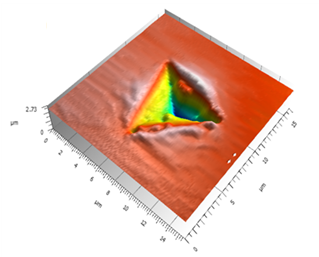Advanced techniques for surface characterisation based on the integration of instrumented indentation testing and topography measurement
Duration: November 2017 – October 2020
Student: Giacomo Maculotti
Supervisors: Richard Leach, Nicola Senin, Maurizio Galetto (Politecnico di Torino, Torino, Italy)
Funding: Scholarship funded by Italian Education and Research Ministry (MIUR)
Instrumented indentation testing (IIT) is an effective method for characterising the mechanical behaviour of materials through the analysis of the force-displacement curve obtained during the implementation of a predefined loading/unloading cycle using a standard hardness indenter (Fig. 1). IIT can be conducted with different load levels (macro, micro, nano-indentation) providing sample characterisation that ranges from bulk to grain properties. Furthermore, IIT allows the evaluation of material elastic modulus through a non-destructive test. Thus, IIT may find application in fields in which the final component has to be characterised because of either safety regulation, such as aerospace, or classical statistical based quality control cannot be applied, as in the case of small production series, e.g. additive manufacturing processes. Therefore, not only component qualification can be achieved but also manufacturing process control. Even if IIT was deeply investigated in the last decade, many issues are still open, such as material sinking-in and piling-up, the effect of contact stiffness and the effect of substrate on thin film characterisation, which are the main criticalities of the test.
Also, the concurrent development of imaging techniques enabled the study of surface topography with high resolution and low measurement uncertainty. Surface texture metrology allows characterisation of the microstructure of the surface of components, which has been demonstrated to affect their macroscopic properties, hence providing an appropriate method to be integrated with IIT (Fig. 2). This project aims at achieving IIT metrological characterisation, eventually to reduce IIT uncertainty, by facing its main critical factors, such as the indentation surface estimation from calibration of indenter tip shape function or from electrical contact resistance (ECR) method to account for sinking-in and piling up, and to couple IIT with surface texture metrology in order to investigate the relationship between surface topography and surface mechanical properties.

Figure 1 Experimental indentation curve force vs displacement (left) and schematic cross section of an indentation (right).

Figure 2 Example of indentation topography measurement.